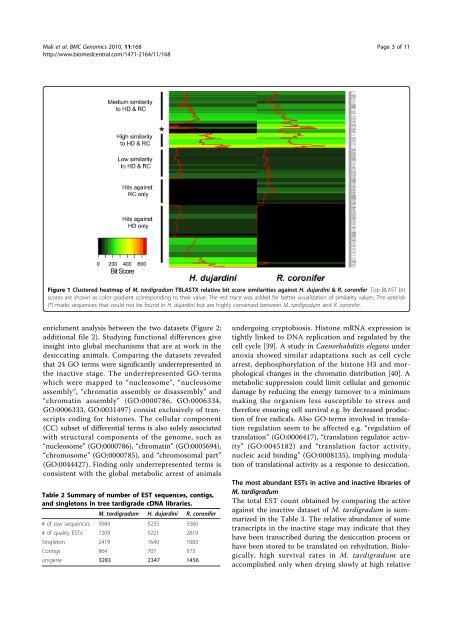Making the most of phylogeny - OPUS - Universität Würzburg
Making the most of phylogeny - OPUS - Universität Würzburg
Making the most of phylogeny - OPUS - Universität Würzburg
Create successful ePaper yourself
Turn your PDF publications into a flip-book with our unique Google optimized e-Paper software.
Mali et al. BMC Genomics 2010, 11:168<br />
http://www.biomedcentral.com/1471-2164/11/168<br />
Figure 1 Clustered heatmap <strong>of</strong> M. tardigradum TBLASTX relative bit score similarities against H. dujardini & R. coronifer. Top BLAST bit<br />
scores are shown as color gradient corresponding to <strong>the</strong>ir value. The red trace was added for better visualization <strong>of</strong> similarity values. The asterisk<br />
(*) marks sequences that could not be found in H. dujardini but are highly conserved between M. tardigradum and R. coronifer.<br />
enrichment analysis between <strong>the</strong> two datasets (Figure 2;<br />
additional file 2). Studying functional differences give<br />
insight into global mechanisms that are at work in <strong>the</strong><br />
desiccating animals. Comparing <strong>the</strong> datasets revealed<br />
that 24 GO terms were significantly underrepresented in<br />
<strong>the</strong> inactive stage. The underrepresented GO-terms<br />
which were mapped to “nucleosome”, “nucleosome<br />
assembly”, “chromatin assembly or disassembly” and<br />
“chromatin assembly” (GO:0000786, GO:0006334,<br />
GO:0006333, GO:0031497) consist exclusively <strong>of</strong> transcripts<br />
coding for histones. The cellular component<br />
(CC) subset <strong>of</strong> differential terms is also solely associated<br />
with structural components <strong>of</strong> <strong>the</strong> genome, such as<br />
“nucleosome” (GO:0000786), “chromatin” (GO:0005694),<br />
“chromosome” (GO:0000785), and “chromosomal part”<br />
(GO:0044427). Finding only underrepresented terms is<br />
consistent with <strong>the</strong> global metabolic arrest <strong>of</strong> animals<br />
Table 2 Summary <strong>of</strong> number <strong>of</strong> EST sequences, contigs,<br />
and singletons in tree tardigrade cDNA libraries.<br />
M. tardigradum H. dujardini R. coronifer<br />
# <strong>of</strong> raw sequences 9984 5235 3360<br />
# <strong>of</strong> quality ESTs 7209 5221 2819<br />
Singleton 2419 1640 1083<br />
Contigs 864 707 373<br />
unigene 3283 2347 1456<br />
Page 3 <strong>of</strong> 11<br />
undergoing cryptobiosis. Histone mRNA expression is<br />
tightly linked to DNA replication and regulated by <strong>the</strong><br />
cell cycle [39]. A study in Caenorhabditis elegans under<br />
anoxia showed similar adaptations such as cell cycle<br />
arrest, dephosphorylation <strong>of</strong> <strong>the</strong> histone H3 and morphological<br />
changes in <strong>the</strong> chromatin distribution [40]. A<br />
metabolic suppression could limit cellular and genomic<br />
damage by reducing <strong>the</strong> energy turnover to a minimum<br />
making <strong>the</strong> organism less susceptible to stress and<br />
<strong>the</strong>refore ensuring cell survival e.g. by decreased production<br />
<strong>of</strong> free radicals. Also GO-terms involved in translation<br />
regulation seem to be affected e.g. “regulation <strong>of</strong><br />
translation” (GO:0006417), “translation regulator activity”<br />
(GO:0045182) and “translation factor activity,<br />
nucleic acid binding” (GO:0008135), implying modulation<br />
<strong>of</strong> translational activity as a response to desiccation.<br />
The <strong>most</strong> abundant ESTs in active and inactive libraries <strong>of</strong><br />
M. tardigradum<br />
The total EST count obtained by comparing <strong>the</strong> active<br />
against <strong>the</strong> inactive dataset <strong>of</strong> M. tardigradum is summarized<br />
in <strong>the</strong> Table 3. The relative abundance <strong>of</strong> some<br />
transcripts in <strong>the</strong> inactive stage may indicate that <strong>the</strong>y<br />
have been transcribed during <strong>the</strong> desiccation process or<br />
have been stored to be translated on rehydration. Biologically,<br />
high survival rates in M. tardigradum are<br />
accomplished only when drying slowly at high relative

















